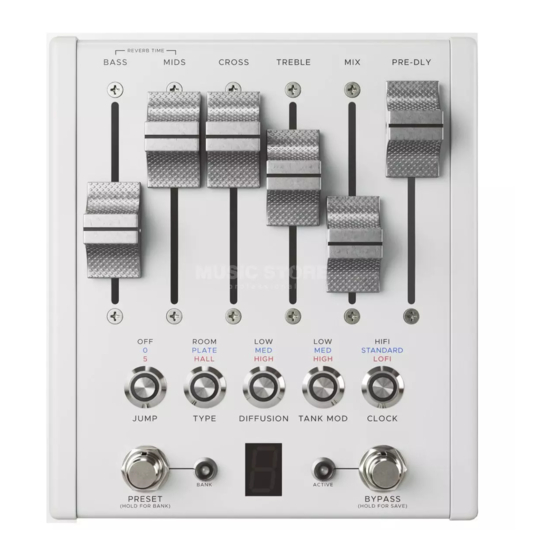
Table of Contents
Advertisement
Quick Links
1978 was a big moment for reverb. It was the dawn of sprawl, the first time reverbs were capable of
massive trails and infinite decay. The CXM1978 reaches back to that moment, allowing you to explore
the charm of those late 70's imperfections, or hifi and lofi reimaginings.
The reverb you'll find here is highly interactive and physical, built from a moving, evolving network of
digital reflections. Each space has its own behaviour and response, just like true reverb. So, let's learn
how to use it.
BASS
MIDS
0 - 362Hz
362 - 1700Hz
CROSS
1700Hz
362Hz CROSSOVER
0Hz
INSTRUCTIONS
FADERS
The flying faders react to preset changes, expression, CV, and
MIDI, offering visual feedback of exactly what's going on.
BASS, MIDS, CROSS, TREBLE
These four faders combine to set the reverb time. The CXM1978
has a unique approach to reverb shaping that focuses on EQ
rather than a simple decay control. By adjusting the EQ, you are
actually setting the absorption of the walls that make up the
reverb tank. The tone and behaviour are interwoven, just like
physical reverb.
BASS
Sets the decay time below the crossover frequency
MIDS
Sets the decay time above the crossover frequency
CROSS
Sets the crossover point of the BASS and MIDS. You can think
of this like a frequency splitter – everything above the crossover
point goes to the MIDS control, everything below goes to the
BASS control. A good way to wrap your head around this is by
turning up the MIDS slider completely, then adjusting CROSS.
With CROSS all the way up, you will have a thin reverb with a
fairly short decay. This is because most frequencies are being
routed to the BASS control. As you bring CROSS down, both the
decay time and EQ expand. The benefit of this approach is you
can give a unique decay time to both the BASS and MIDS, and
set exactly how to divide the two. This can be used to create
a pad of bass reverb that sits neatly beneath your playing, for
example. The range is from 0 Hz to 1700 Hz.
TREBLE
Darkens the reflections by increasing absorption. TREBLE is
a good example of how the EQ is interconnected – even with
MIDS and BASS at max, the decay time will be quite short with
TREBLE at minimum.
MIX
Sets the analog balance between the Wet and Dry signals.
PRE-DLY
Sets the delay before the onset of the reverb. The range of the
pre-delay slider is set by the CLOCK button. Additionally, the
HIGH setting of the DIFFUSION button adds a unique smeared
feedback to the pre-delay for flanged textures at short times
and smooth organic echoes at longer times (see CLOCK for
more on this).
Advertisement
Table of Contents

Summary of Contents for Meris AUTOMATONE CXM 1978
- Page 1 INSTRUCTIONS 1978 was a big moment for reverb. It was the dawn of sprawl, the first time reverbs were capable of massive trails and infinite decay. The CXM1978 reaches back to that moment, allowing you to explore the charm of those late 70’s imperfections, or hifi and lofi reimaginings. The reverb you’ll find here is highly interactive and physical, built from a moving, evolving network of digital reflections.
- Page 2 FOOTSWITCH FUNCTIONS PRESET/BANK This button toggles between 10 saved presets (0-9 on the LED Display) for each bank. Holding down the PRESET/BANK button selects between the three banks indicated by the Bank LED, which is unlit for the first bank of presets, RED for the second bank, GREEN for the third bank.
- Page 3 EXPRESSION To connect an expression pedal, insert a TRS cable from the expression pedal to the EXP jack on the back of the pedal. By default, the expression pedal controls no parameters and will need to be assigned to the sliders. This can also be used for 0-5V Control Voltage (CV).
- Page 4 PRESET NAME PRESET NAME HOVERBOARD SCATTERED THOUGHTS Low, bass-focused reverb pad Wispy multi-tap clusters PRESET NAME PRESET NAME NATURAL ACOUSTICS WANDERING WIND Pure, intimate room sound Feed it a note and watch it move...
- Page 5 PRESET NAME PRESET NAME ROTATING CHIME DISTANT ECHOES Regenerating lofi artifacts with swirling modulation Dissolving delay/reverb combo PRESET NAME PRESET NAME WORLD’S BIGGEST ROOM BENDING HALL Impossible room with billowing trails Classy hall with surreal modulation...
- Page 6 PRESET NAME PRESET NAME BOTTOMLESS ALMOST 80’s Yeah, infinite reverb, nice Vintage modulated plate This device complies with part 15 of the FCC rules. Operation is subject to the following two conditions: (1) This device may not cause harmful interference, and (2) this device must accept any interference received, including interference that may cause undesired operation.




Need help?
Do you have a question about the AUTOMATONE CXM 1978 and is the answer not in the manual?
Questions and answers